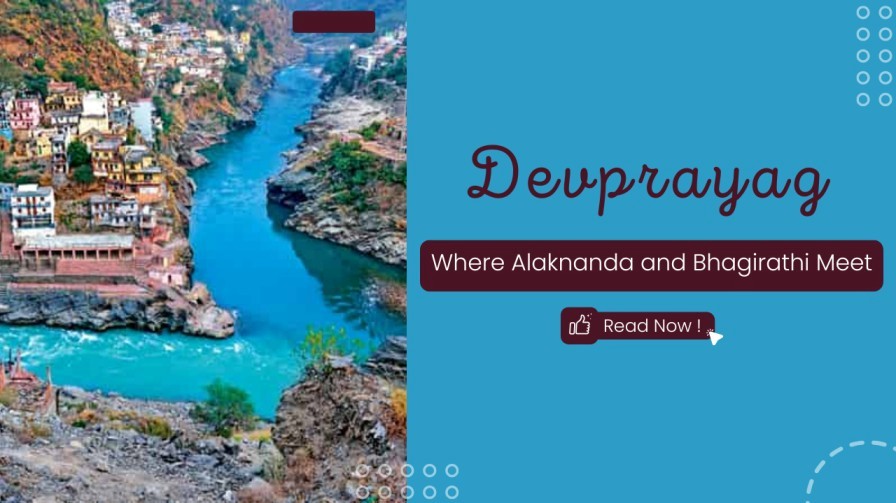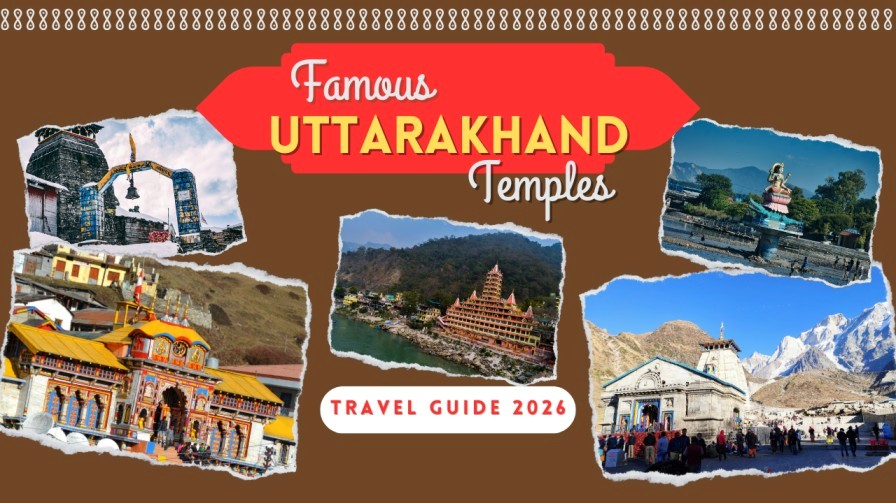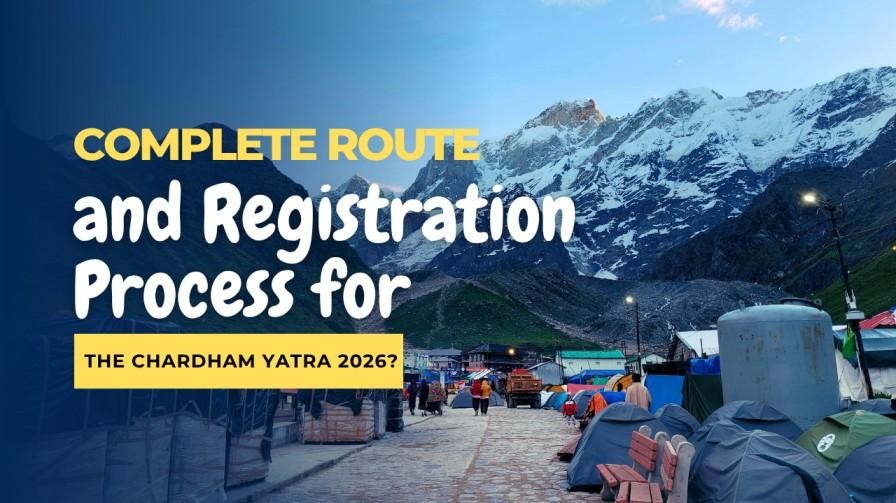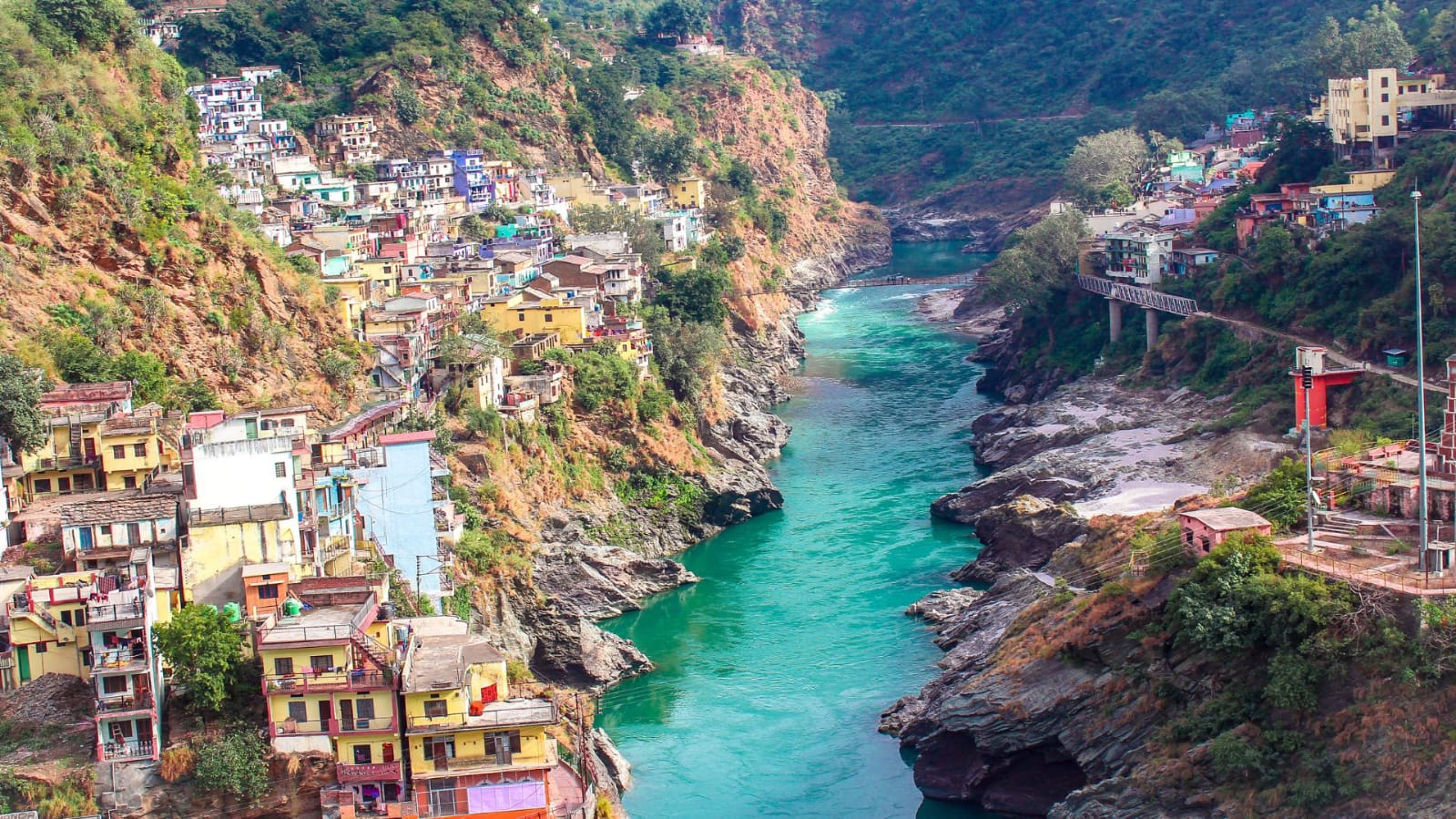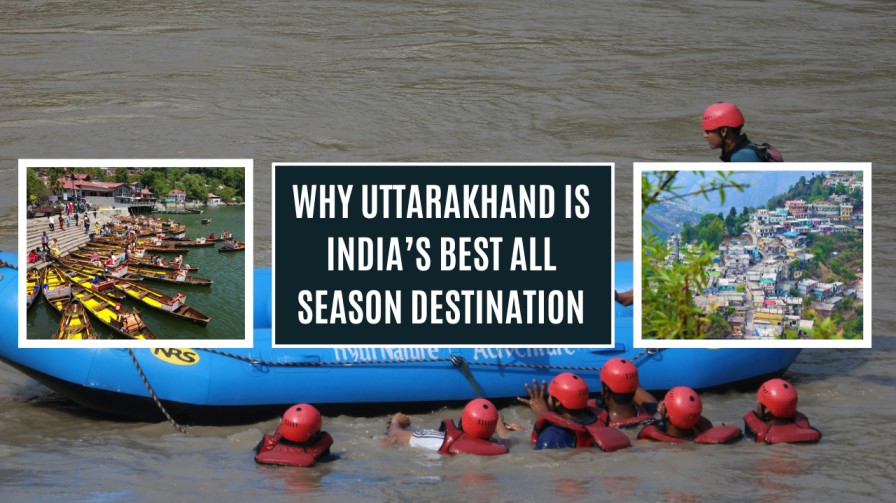Nestled in the serene lap of the Himalayas lies Devprayag – Where Alaknanda and Bhagirathi Meet, marking the origin of the Ganga River. This sacred confluence, known as the Devprayag Sangam, is not only a geographical marvel but also a deeply spiritual destination that attracts thousands of pilgrims and travellers each year. From mythological legends to mesmerizing natural beauty, Devprayag stands as a testament to India’s divine heritage. The Confluence of Alaknanda and Bhagirathi Rivers At Devprayag, two mighty Himalayan rivers — Alaknanda and Bhagirathi — merge gracefully to form the holy Ganga River. The merging of these rivers at Devprayag symbolizes the union of knowledge and spirituality, creating one of India’s most sacred water bodies — the Ganga. Spiritual Significance of Devprayag The spiritual significance of Devprayag is rooted in ancient Hindu scriptures and mythology. It is believed that Lord Rama and King Dasharatha performed penance here to wash away their sins. The place is said to be blessed by Lord Vishnu, making it one of the holiest pilgrimage sites in India. Pilgrims believe that taking a dip in the Devprayag Sangam cleanses the soul of past karma and brings spiritual enlightenment. The Raghunathji Temple, dedicated to Lord Rama, stands as the town’s spiritual heart. Devprayag’s spiritual experience: Pilgrimage to Devprayag Uttarakhand Devprayag holds immense importance for devotees undertaking the Char Dham Yatra. It serves as a vital stop between Rishikesh and Badrinath, offering both spiritual solace and scenic beauty. Best Time to Visit Devprayag The best time to visit Devprayag depends on what you want to experience — spiritual calm, pleasant weather, or scenic river views. Summer (March to June) Monsoon (July to September) Winter (October to February) Devprayag Tourism: A Blend of Nature and Divinity Apart from its religious aura, Devprayag tourism offers a peaceful retreat for travellers seeking nature, adventure, and culture.You can explore: Nearby Attractions Around Devprayag If you’re planning a trip to Devprayag – Where Alaknanda and Bhagirathi Meet, you’ll find plenty of fascinating destinations nearby that beautifully combine spirituality, adventure, and Himalayan charm. These make your Devprayag tourism experience even more memorable. Raghunathji Temple (0 km) Located right in Devprayag town, this ancient temple is dedicated to Lord Rama. Its intricate carvings and peaceful ambiance make it the spiritual heart of the town. Rishikesh (70 km) Known as the Yoga Capital of the World, Rishikesh offers yoga retreats, river rafting, and the iconic Lakshman Jhula. It’s an ideal stop for spiritual seekers and adventure lovers alike. Srinagar Garhwal (35 km) A scenic town on the banks of the Alaknanda River, Srinagar is known for its serene ghats and the Kamleshwar Mahadev Temple. It’s also a great base for exploring the Garhwal region. Tehri Dam (60 km) One of Asia’s tallest dams, Tehri Dam is a modern engineering marvel. Visitors can enjoy water sports like jet skiing, boating, and parasailing at Tehri Lake. Chandrabadani Temple (35 km) Perched on a hilltop at 2,277 meters, this Shakti Peeth is believed to be the spot where parts of Goddess Sati fell. The panoramic view of the Garhwal Himalayas is breath-taking. Kaudiyala (50 km) A popular river-rafting site between Devprayag and Rishikesh, Kaudiyala is perfect for thrill-seekers. The Ganga’s rapids here range from Grade II to IV, offering an adrenaline-pumping experience. Origin of the Ganga River: A Divine Legacy The origin of the Ganga River at Devprayag is both a natural and spiritual phenomenon. According to mythology, the Ganga descended from heaven to cleanse the earth of sins, and it is here, at Devprayag, that her earthly journey truly begins. The sight of the turquoise Alaknanda merging with the greenish Bhagirathi is awe-inspiring a visual symbol of purity, devotion, and divine unity. Why Visit Devprayag Devprayag – Where Alaknanda and Bhagirathi Meet is a peaceful and sacred place in Uttarakhand. It’s known as the origin of the Ganga River, making it one of the most important pilgrimage sites in India. Here’s why you should visit: Whether you come for faith, peace, or nature, Devprayag Uttarakhand offers a truly divine experience. FAQs about Devprayag 1. What is special about Devprayag?Devprayag is the sacred confluence where the Alaknanda and Bhagirathi rivers meet to form the Ganga River, a major pilgrimage site in Uttarakhand. 2. Which rivers meet at Devprayag?The Alaknanda River from Badrinath and the Bhagirathi River from Gaumukh merge at Devprayag. 3. What is the best time to visit Devprayag?October to April offers the best weather for sightseeing and spiritual activities. 4. How can I reach Devprayag from Rishikesh?You can reach Devprayag by road (around 70 km), with regular taxis and buses available. 5. Is Devprayag part of the Char Dham Yatra?Yes, it is often included as a sacred stop on the Char Dham pilgrimage route in Uttarakhand. Visiting Devprayag? Here’s Why Clan Stays Is Your Best Choice Visiting Devprayag – Where Alaknanda and Bhagirathi Meet is a spiritually enriching experience, and having the right stay makes all the difference. Clan Stays offers cozy, comfortable accommodations close to the sacred Devprayag Sangam, perfect for pilgrims and travellers alike. Guests can enjoy stunning river views, warm local hospitality, and easy access to nearby temples and attractions. With Clan Stays, your Devprayag trip becomes both peaceful and memorable.
Top 25 Tourist Places to Visit in Uttarakhand 2026 – Complete Travel Guide
Introduction – The Land Where Gods Walk the Earth Uttarakhand isn’t just a destination — it’s a feeling.Known as Devbhumi, or “The Land of the Gods,” this Himalayan state holds centuries of spiritual heritage, where rivers are sacred, mountains are divine, and every temple has a story to tell. Whether it’s the echoing chants in Kedarnath, the peaceful ghats of Haridwar, or the mystical silence of Jageshwar — every corner of Uttarakhand breathes devotion. In this Uttarakhand temple travel guide 2026, we’ll walk you through the most famous temples in Uttarakhand, their history, how to reach them, and the best time to experience their divine charm. Let’s begin your spiritual journey. 1. Kedarnath Temple – The Soul of Shiva If there’s one temple that defines Uttarakhand’s divinity, it’s Kedarnath Temple. Perched at an altitude of 11,755 feet, this sacred shrine is one of the most visited temples in Uttarakhand and part of the holy Char Dham Yatra. Dedicated to Lord Shiva, the temple stands bravely amidst the snow-covered Himalayas — a symbol of faith that has withstood floods, earthquakes, and time itself. Why Visit: How to Reach:Trek 16 km from Gaurikund (can also hire ponies or palanquins). Helicopter services are available from Guptkashi and Phata. Best Time to Visit: May to October (temple remains closed in winter). 2. Badrinath Temple – The Abode of Lord Vishnu Situated along the Alaknanda River, Badrinath Temple is one of the most sacred Hindu temples in Uttarakhand. It’s believed that Lord Vishnu meditated here under the Badri tree, while Goddess Lakshmi sheltered him as a form of love. The temple’s bright colors, snow peaks, and divine serenity make it a must-visit for every devotee. Why Visit: Best Time to Visit: May to October 3. Gangotri Temple – The Sacred Birthplace of the Ganges At 10,200 feet above sea level, Gangotri Temple marks the origin of the River Ganga — believed to have descended from heaven to cleanse humanity of its sins. The white stone temple stands gracefully beside the Bhagirathi River, surrounded by snow peaks and pine forests. Highlights: Travel Tip: Combine Gangotri with nearby Harsil village for a peaceful stay. Best Time to Visit: May to October 4. Yamunotri Temple – Origin of the River Yamuna Located in the western Garhwal Himalayas, Yamunotri Temple is the first stop in the Char Dham Yatra. Dedicated to Goddess Yamuna, this temple is surrounded by glaciers and thermal springs. Pilgrims trek from Janki Chatti to reach the shrine, passing through waterfalls and rhododendron forests. Why Visit: Best Time: May to October 5. Tungnath Temple – The Highest Shiva Temple in the World Nestled at 12,000 feet in the Chandrashila range, Tungnath is not just a temple — it’s a feeling of being closer to the divine. Believed to be built by the Pandavas, this is the highest Shiva temple in the world. The short 4 km trek from Chopta is scenic, with meadows, forests, and views of snow peaks. Highlights: Best Time: April to November 6. Jageshwar Dham – The Ancient Valley of Temples Hidden amidst the deodar forests of Almora, Jageshwar Dham is one of the most peaceful spiritual places to visit in Uttarakhand. It’s a complex of over 120 stone temples dating back to the 9th century, all dedicated to Lord Shiva. The place is serene, historic, and filled with positive energy. Why Visit: Best Time: April to June, September to November 7. Dhari Devi Temple – The Protector Goddess of Uttarakhand Located between Srinagar and Rudraprayag, Dhari Devi Temple is dedicated to Goddess Kali in her fierce form. The temple stands on a small rock island in the Alaknanda River. Locals believe she protects Uttarakhand from calamities, and her idol is half submerged in water — changing form with time of day. Unique Belief:Morning – Child formAfternoon – Young womanEvening – Old lady Best Time: March to June, September to November 8. Kalimath Temple – The Power of Shakti Among the 108 Shakti Peethas, Kalimath Temple near Guptkashi is one of the holiest. Dedicated to Goddess Kali, it’s believed that she killed the demon Raktabeej here and disappeared into the ground. The idol is not visible — she is worshipped underground, symbolizing divine power hidden in the earth. Why Visit: Best Time: March to June, September to November 9. Neelkanth Mahadev Temple – Shiva’s Mythical Shrine Located just 30 km from Rishikesh, Neelkanth Mahadev Temple sits at 1,300 meters, surrounded by dense forests and valleys. It marks the spot where Lord Shiva drank poison from the churning of the ocean (Samudra Manthan), turning his throat blue — earning him the name Neelkanth (Blue Throat). Highlights: Best Time: October to March 10. Surkanda Devi Temple – Where Faith Meets the Sky Located near Dhanaulti, Surkanda Devi Temple is one of the most beautiful Hindu temples in Uttarakhand. It’s said to be the place where Goddess Sati’s head fell when Lord Shiva carried her burned body after the Daksha Yagna. To reach the temple, devotees hike about 2 km uphill through pine forests, rewarded with a stunning 360° view of the Himalayas and Doon Valley. Best Time: March to June, September to November 11. Nanda Devi Temple – Goddess of the Himalayas Located in Almora, Nanda Devi Temple is dedicated to the goddess regarded as the protector of Uttarakhand. The temple’s annual Nanda Devi Fair is a colourful celebration of culture, devotion, and local traditions. Highlights: 12. Baijnath Temple – Lord Shiva’s Eternal Presence Situated along the Gomti River in Bageshwar, Baijnath Temple is known for its timeless stone architecture and mythological link — it is believed Lord Shiva married Goddess Parvati here. Why Visit: Best Time: October to March 13. Kainchi Dham Temple – The Ashram of Miracles Kainchi Dham near Nainital is a modern spiritual site that gained global fame due to Neem Karoli Baba, a saint revered for his wisdom and miracles. It’s visited by thousands, including tech icons like Steve Jobs and Mark Zuckerberg, who credited their visits here for
What Is the Complete Route and Registration Process for the Chardham Yatra 2026?
Introduction The Chardham Yatra in Uttarakhand is one of the known Yatra in India. Every year, thousands of travellers from across the world visit the four holy Temples— Yamunotri, Gangotri, Kedarnath, and Badrinath — located in the Garhwal region of Uttarakhand. The journey is not just a religious experience but also a chance to reconnect with nature and find inner peace. If you planning Chardham Yatra in 2026 , it’s the perfect time to plan your spiritual journey. In this blog, I will guide you through everything you need to know — from the route, registration process, itinerary, best time to visit, package details, and why choosing Clans Stays will make your trip comfortable and unforgettable. How to Reach Haridwar – The Starting Point of Chardham Yatra Most travellers start their Chardham Yatra from Haridwar, known as the “Gateway to God.” Haridwar is well-connected by road, rail, and air from Delhi making it the ideal starting point for your journey. By Air: By Train: By Road: Overview of the Chardham Yatra The Chardham Yatra circuit includes four sacred Temples located in the Garhwal Himalayas of Uttarakhand. Each dham represents a different Story of Hindu spirituality: Chardham Route Map The traditional route follows this sequence:Haridwar → Barkot → Yamunotri → Barkot → Uttarkashi → Gangotri → Uttarkashi → Guptkashi → Kedarnath → Guptkashi → Badrinath → Haridwar Chardham Yatra Registration Process 2026 Before starting your Char Dham Yatra, registration is mandatory as per the Uttarakhand Tourism Department. This ensures the safety and tracking of every traveller. Online Registration process Steps: Offline Registration: If you prefer offline registration, Carry Your Aadhaar Card and you can visit authorized counters at: Once registered, you will receive a QR code and Yatra Card, which must be scanned at each dham for tracking and safety purposes. Same Yatra Card is Required to make the E pass for the Taxi As Well. Sample Itinerary for Chardham Yatra 2026 Clans Stays offers both road packages and helicopter packages for the Chardham Yatra from Haridwar. Below is a sample itinerary for both options. Chardham Yatra by Road ( 9 Nights /10 Days ) Day 1: Haridwar – Barkot (Yamunotri) Distance: 190 km | Duration: 6–7 hoursDrive via Mussoorie and Kempty Falls to reach Barkot, a small hill town by the Yamuna River. Enjoy scenic mountain views and rest at your hotel.Overnight Stay: Barkot Day 2: Barkot – Yamunotri – Barkot Distance: 45 km (drive) + 6 km (trek one way) | Duration: Full dayEarly morning, drive to Janki Chatti. Start the 6 km trek to Yamunotri Temple (you can hire a pony or doli). Take a holy dip in Surya Kund and trek to Yamunotri Temple. Return to Barkot by evening.Overnight Stay: Barkot Day 3: Barkot – Uttarkashi (Gangotri Base) Distance: 85 km | Duration: 4–5 hoursAfter breakfast, drive to Uttarkashi, located on the banks of the Bhagirathi River. Visit Vishwanath Temple and explore the local market of Uttarkashi.Overnight Stay: Uttarkashi Day 4: Uttarkashi – Gangotri – Uttarkashi Distance: 100 km (one way) | Duration: 3.5–4 hours each sideDrive along the Bhagirathi River and Harsil Valley to reach Gangotri. Take a holy dip in the sacred Ganges and perform darshan at Gangotri Temple. Return to Uttarkashi by evening.Overnight Stay: Uttarkashi Day 5: Uttarkashi – Guptkashi Distance: 220 km | Duration: 8–9 hoursA scenic drive through mountain valleys and along the Mandakini River. Overnight Stay: Guptkashi Day 6: Guptkashi – Kedarnath (Trek / Helicopter) Distance: 30 km (drive to Sonprayag) + 22 km (trek one way) | Duration: Full dayDrive early to Sonprayag, then take a local jeep to Gaurikund. From there, begin your trek (or helicopter ride from Phata/Sersi) to Kedarnath Temple. Attend the evening Aarti near the temple .Overnight Stay: Kedarnath Day 7: Kedarnath – Guptkashi Distance: 22 km (trek) + 30 km (drive) | Duration: 5–6 hoursAfter morning darshan, return to Gaurikund and then to Guptkashi by evening. Relax and recover from the trek.Overnight Stay: Guptkashi Day 8: Guptkashi – Badrinath Distance: 185 km | Duration: 7–8 hoursAfter breakfast, proceed to Badrinath via Joshimath. Visit the sacred Narsingh Temple at Joshimath before going to Badrinath. Attend evening Aarti at Badrinath Temple.Overnight Stay: Badrinath Day 9: Badrinath – Joshimath – Rudraprayag Distance: 160 km | Duration: 6–7 hoursTake an early morning dip in Tapt Kund and offer prayers at Badrinath Temple. Visit nearby attractions — Mana Village, Vyas Gufa, and Bhim Pul( a short drive of 10 mins )— before driving to Rudraprayag via Joshimath.Overnight Stay: Rudraprayag Day 10: Rudraprayag – Haridwar (via Rishikesh) Distance: 160 km | Duration: 5–6 hoursDrive back to Haridwar via Rishikesh, visiting Devprayag — En route, witness the confluence of Alaknanda and Bhagirathi at Devprayag.Your Chardham Yatra concludes after reaching Haridwar with lifelong memories.End of Yatra Chardham Yatra by Helicopter (6 Days / 5 Nights) Day 1 – Arrival at Dehradun (Stay in Dehradun) Overnight Stay: Dehradun Day 2 – Dehradun → Yamunotri (Kharsali Helipad) → Barkot (Stay) Overnight Stay: Barkot Day 3 – Barkot → Harsil Helipad → Gangotri Darshan → Harsil (Stay) Overnight Stay: Harsil Day 4 – Harsil → Guptkashi (Sersi Helipad) → Kedarnath Darshan → Return to Guptkashi (Stay) Overnight Stay: Guptkashi / Sersi Day 5 – Guptkashi (Sersi) → Badrinath (Stay) Overnight Stay: Badrinath Day 6 – Badrinath → Dehradun (Drop) End of Tour with Divine Blessings Approximate Helicopter & Transfer Durations Route Approx. Flight Time Dehradun → Kharsali (Yamunotri) 30 minutes Kharsali → Harsil (Gangotri Sector) 30 minutes Harsil → Sersi (Guptkashi Base) 30 minutes Sersi → Kedarnath (Shuttle) 7–10 minutes each way Sersi → Badrinath 30 minutes Badrinath → Dehradun 60 minutes Harsil → Gangotri (by road) 25 km / 45–50 minutes Package Options & Prices (Estimated for 2026) Package Type Duration Mode Starting Price (Per Person) Standard Chardham Yatra 10 Days / 9 Nights Road ₹25,000 – ₹35,000 Deluxe Chardham Yatra 10 Days / 9 Nights Road ₹35,000 – ₹45,000 Luxury Chardham Yatra 10 Days / 9 Nights Road ₹45,000 – ₹65,000 Chardham Helicopter Yatra
Land of Gods Uttarakhand: Spiritual Pilgrimage and Sacred Temples
Why is Uttarakhand Called the Land of Gods? Uttarakhand is often called the Land of Gods Uttarakhand because it is believed to be filled with spiritual energy. In addition, countless ancient temples and rich traditions of worship are found across the state. It is said that the divine presence can be felt in its mountains, rivers, and serene surroundings. Therefore, pilgrims and travelers visit Uttarakhand seeking peace, devotion, and a closer connection with the divine. The Spiritual Essence of Uttarakhand In Uttarakhand, nature and devotion are beautifully intertwined. Mountains, rivers, and forests create an atmosphere of calm and reflection. Moreover, many seekers are drawn to this land for meditation, inner growth, and spiritual rejuvenation. As a result, Uttarakhand has become a renowned destination for spiritual tourism Uttarakhand, offering serenity and sacredness in every corner. Meaning of “Devbhoomi” – The Land of Gods The term Devbhoomi literally means “Land of Gods.” It is believed that divine energy is present throughout Uttarakhand, in every mountain, river, and forest. Consequently, the state has been considered holy for centuries. Pilgrimages are undertaken here for prayer, meditation, and spiritual growth, making it one of India’s most revered destinations. Mythological Importance of Uttarakhand Uttarakhand is prominently mentioned in Indian mythology. It is believed to be the playground of gods and the residence of sages who performed penance for years. Furthermore, many legends suggest that divine events, such as the descent of holy rivers and visits by gods, took place in this region. Thus, its mountains, rivers, and forests are often associated with mythological stories, attracting pilgrims from across the country. Connection with Ancient Hindu Scriptures The sacred mountains, rivers, and forests of Uttarakhand are described in ancient Hindu texts like the Vedas, Puranas, and epics. It is said that meditation, penance, and divine presence were central to this land. Many temples are linked to stories of gods and sages. Therefore, Uttarakhand has been revered as a destination for spiritual growth and blessings. The Sacred Rivers: Ganga & Yamuna Uttarakhand is the source of two of India’s most sacred rivers: the Ganga and Yamuna. They are worshipped for their life-giving and purifying powers. Pilgrims often visit their sources to perform rituals and offer prayers. Moreover, these rivers are central to many mythological stories, symbolizing purity, devotion, and the divine presence in nature. Home to the Famous Char Dham Yatra The Char Dham Yatra is regarded as one of Hinduism’s most sacred pilgrimages. Every year, thousands of devotees are drawn to this journey for blessings and spiritual renewal. The pilgrimage is considered a path of faith, devotion, and inner purification. Furthermore, Uttarakhand’s natural beauty enhances the spiritual experience, making the journey both physically and spiritually enriching. Famous Temples of Uttarakhand Kedarnath Temple – Dedicated to Lord Shiva and located in Rudraprayag, Kedarnath is believed to have been built by the Pandavas and later revived by Adi Shankaracharya. Its remote Himalayan location makes the pilgrimage challenging yet spiritually rewarding. Badrinath Temple – Surrounded by snow-capped peaks and the Alaknanda River, this temple dedicated to Lord Vishnu is considered sacred for worship and spiritual learning. Devotees are drawn to this site to experience divine energy. Yamunotri Temple – Dedicated to Goddess Yamuna, Yamunotri marks the origin of the Yamuna River. A challenging trek is undertaken by pilgrims to seek blessings and purification. Gangotri Temple – Dedicated to Goddess Ganga, Gangotri marks the sacred origin of the Ganga River. According to legend, King Bhagirath brought the river to Earth through penance, and devotees visit to experience its spiritual power. Panch Kedar – Refers to five sacred Shiva temples: Kedarnath, Tungnath, Rudranath, Madhyamaheshwar, and Kalpeshwar. Each temple is believed to hold unique spiritual significance. Panch Badri – Five Vishnu temples: Badrinath, Adi Badri, Vriddha Badri, Bhavishya Badri, and Yogadhyan Badri, where devotees seek blessings and inner peace. Panch Prayag – Five sacred river confluences: Vishnuprayag, Nandaprayag, Karnaprayag, Rudraprayag, and Devprayag. These sites are regarded as holy for rituals and blessings. Sacred Cities & Spiritual Hubs Haridwar – Known as the Gateway to the Gods, Haridwar is famous for the Ganga Aarti and the Kumbh Mela festival. Rishikesh – Regarded as the Yoga Capital of the World, Rishikesh attracts devotees, yoga practitioners, and spiritual seekers globally. Its ashrams and riverside ghats provide a peaceful environment for reflection and meditation. Adi Kailash & Om Parvat – Sacred peaks representing Lord Shiva and the “Om” symbol. Pilgrims undertake treks to experience their spiritual energy. The Himalayas – Considered the abode of deities, inspiring devotion, awe, and meditation. Tungnath – The highest Shiva temple in the world, offering breathtaking Himalayan views and spiritual fulfillment. Neelkanth Mahadev – Associated with Lord Shiva consuming poison during Samudra Manthan. Pilgrims visit for blessings and rituals. Jageshwar – 124 ancient Shiva temples, referred to as the “Mini Kashi of the Himalayas.” Surkanda Devi – Temple of Goddess Parvati, believed to be one of the 51 Shakti Peethas. Kainchi Dham – The ashram of Neem Karoli Baba, known for spiritual guidance and meditation, attracting devotees worldwide. Ancient Legends, Saints, and Festivals Uttarakhand is steeped in legends and folklore, with stories of gods, sages, and divine miracles passed down for generations. Saints, rishis, and sages are said to have meditated here, performing penance and sharing spiritual wisdom. Festivals such as Ganga Dussehra, Kumbh Mela, and Makar Sankranti are celebrated with devotion, reflecting the state’s spiritual and cultural richness. Uttarakhand – The Gateway to Heaven Due to its sacred rivers, ancient temples, and majestic Himalayan landscapes, Uttarakhand is often regarded as the Gateway to Heaven. Pilgrims are said to feel a deep spiritual connection, attaining peace and devotion. Furthermore, challenging yet rewarding journeys, combined with mythological significance, create a divine experience. Travel Stress-Free with Clan Stays Planning a pilgrimage can often be overwhelming. With Clan Stays, accommodations, transport, itineraries, and local guidance are provided. Pilgrims can focus entirely on worship, exploration, and spiritual experiences. Safety, comfort, and convenience are prioritized, ensuring a smooth and memorable journey. Explore More Blogs:
Why Uttarakhand is India’s Best All-Season Destination
Uttarakhand is widely known as the best all-season destination in India because it feels magical throughout the year. In spring and summer, it’s cool breeze and blooming valleys offer a perfect escape from the city heat. Monsoons bring life to the hills, turning them lush green and painting the landscapes with wildflowers. Autumn opens up clear skies and golden forests, ideal for quiet walks and mountain views. In winter, snow blankets the mountains, creating a dreamy, romantic setting. You can plan a trip to Uttarakhand anytime, in any season, on any day—that’s what truly makes it special compared to other destinations. It’s not just a place to visit, it’s an experience that changes beautifully with time. Check our Complete Uttarakhand Travel Guide for detailed itineraries and travel tips. Table of Contents Spring in Uttarakhand – Crisp air, vibrant flowers, and unforgettable outdoor adventures In spring, Uttarakhand feels like a fresh breath of life—blooming flowers, soft sunshine, and cool mountain air. The valleys turn green, the skies stay clear, and gentle waterfalls begin to flow again. Birds sing in the background as nature slowly wakes up. For tourists, it’s the perfect time to relax, breathe, and soak in peaceful beauty. Spring is the perfect season to explore these vibrant spots: Summer in Uttarakhand – Cool hill stations, pilgrimages, and thrilling adventures Summer in Uttarakhand brings cool mountain breezes and vibrant sunshine, perfect for thrilling river rafting and cozy riverside camping under starry skies. Trek through blooming alpine meadows and scenic trails that reveal the Himalayas in their full glory. Participate in sacred yatra journeys to ancient temples, experiencing deep spirituality and colourful local festivals. Explore dense forests on wildlife safaris, spotting exotic birds and elusive wildlife. Enjoy cable car rides and boating on serene lakes surrounded by lush greenery. Feel the adrenaline rush with paragliding and ziplining over breathtaking valleys, soaking in the crisp mountain air. Beat the heat by discovering these refreshing summer escapes: Monsoon in Uttarakhand – Lush greenery, peaceful retreats, and the Valley of Flowers Monsoon in Uttarakhand brings the hills alive with vibrant green forests and misty, rain-dappled valleys. The cool, fresh air carries the scent of wet earth and blossoming flora, creating a peaceful and rejuvenating atmosphere. It’s an ideal time for gentle nature walks along lush trails, capturing waterfalls in full flow through your lens, and enjoying quiet moments of spiritual reflection. Wildlife comes alive, making it a great season for mindful animal and bird watching. Though heavy rains limit intense treks, easy hikes and cultural visits provide a soulful connection to the land. Be prepared with rain gear to fully embrace the serene monsoon magic. Visit these places when the hills turn vibrant with rain: Autumn in Uttarakhand – Clear skies, festive vibes, and golden landscapes Autumn in Uttarakhand paints the landscape in warm hues of gold, amber, and crimson beneath clear blue skies. Gentle breezes carry the scent of pine and fallen leaves, while rivers sparkle under soft sunlight. It’s the perfect season for trekking, peaceful nature walks, and capturing stunning photographs. Panoramic mountain views and vibrant forests create a serene atmosphere that invites quiet reflection. The calm surroundings offer a soulful escape into nature’s tranquil beauty. Don’t skip these places when the hills wear autumn’s charm: Winter in Uttarakhand – Snowy escapes, skiing, and cozy mountain getaways Winter in Uttarakhand brings quiet snowfall over hills, forests, and rooftops, turning villages and valleys into peaceful white landscapes. The mornings are crisp, with frost-covered trees and smoke curling from chimneys. Sunlight filters through icy skies, casting a golden glow on distant snow-covered peaks. Streams slow down, and the silence of the mountains deepens. Locals go about their routines wrapped in wool, while visitors enjoy the stillness, warmth of bonfires, and the raw beauty of the cold. Winter isn’t complete until you’ve been here: Cultural and Spiritual Diversity – Year-round festivals, traditions, and sacred spaces Uttarakhand, known as Dev Bhoomi (Land of the Gods), is deeply rooted in spiritual practice and cultural tradition. The state is home to the sacred Char Dham Yatra — Yamunotri, Gangotri, Kedarnath, and Badrinath — which draws lakhs of pilgrims each year, especially in summer and early autumn. These shrines are not just places of worship but deeply connected to mythological and historical roots. Beyond Char Dham, spiritual centres like Haridwar (famous for the Ganga Aarti at Har Ki Pauri) and Rishikesh (known for yoga, ashrams, and the International Yoga Festival) attract both devotees and seekers worldwide. Other revered sites include Hemkund Sahib, Neelkanth Mahadev, Jageshwar Dham (with over 100 ancient temples), Baijnath Temple, and Mahasu Devta Temple in Jaunsar-Bawar region. The cultural calendar is vibrant too — festivals like Harela, Phool Dei, Ganga Dussehra, Kandali Festival, and Makar Sankranti reflect the rhythms of agriculture, nature, and local beliefs. Regional folk music like Jagar, Mangal, Jhoda, and traditional dances like Chholiya enrich every celebration. In Uttarakhand, spirituality is not separate from daily life — it flows through every season, every valley, and every village. From grand yatras to simple forest shrines, this is truly the best all-season destination in India where faith and culture breathe in harmony.

